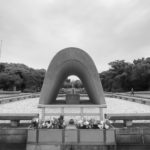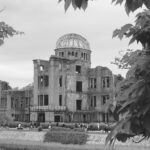Hiroshima
It was an emotional day, spent contemplating the horrors experienced by the people of Hiroshima on August 6, 1945, when, at 8:15 a.m., an atomic bomb was dropped on the city’s busiest downtown commercial and residential area. That area is now covered by Hiroshima Memorial Peace Park, a beautiful space designed for the purpose of promoting peace and to honour the memory of the 70,000 people who died immediately from the consequences of the intense heat, blast and radiation and a further 70,000 who died later. The names of all the known victims of the bomb are inscribed in the Cenotaph, while the Atomic Bomb Memorial Mound contains the ashes of thousands of unclaimed or unidentifiable victims. Radiation led to further suffering of those who survived. About 1 in 10 of the dead were Koreans in Japan “for various reasons”. This phrase used in the Museum actually includes forced labour and so called “comfort women”. Non-Japanese could not obtain medical care after the attack nor assistance for the long term consequences of exposure until 1980.
The Children’s Peace Monument, a statue of a girl with outstretched arms with a folded paper crane rising above her, was poignantly strung with hundreds of tiny origami cranes made by children around the world. The monument was inspired by a young girl, Sadako Sasaki, who was two years old at the time of the atomic bomb and is dedicated to all of the children who perished because of the bomb. When Sadako developed leukaemia at 11 years of age, she decided to fold 1000 paper cranes. The crane is the symbol of longevity and happiness and Sadako believed if she achieved that target she would recover. Although she folded 1300, she died within eight months. The Peace Flame is set to burn until all of the world’s nuclear weapons have been destroyed.
In the Hiroshima Peace Memorial Museum, we watched riveting video testimony of people who had survived, looked at personal items left by those who didn’t – tattered clothing, a child’s melted lunchbox, a wristwatch stopped at 8:15 – and saw exhibits that describe Hiroshima before and after the bombings. The museum also documents the development of the atomic bomb and nuclear arms and presents the current status of international efforts to reduce and eliminate the threat of use of such weapons.
The A Bomb Dome is the icon of the devastation. The Hiroshima Prefectural Industrial Promotion Hall, built in 1915, was one of the few buildings to remain somewhat intact. The bomb was detonated 600 m above the Dome close to a T-shaped bridge which was used as the target.
Three days later, a second bomb was dropped on Nagasaki. Before the bombings, Japan was already developing terms of surrender. People were suffering from the results of fire bombing of major cities with shortages of food and other supplies and evacuation of children to the countryside. In 1946, when the US was occupying Japan, President Truman ordered the establishment of the Atomic Bomb Casualty Commission in Hiroshima, to investigate the after effects of the atomic bomb. A-bomb survivors had high expectations that the Commission would treat their illnesses, but the body only performed examinations and research.
Japanese were again affected when fishers were exposed to radiation from nuclear tests in the Pacific in 1954.







I appreciate your black and white photos of Hiroshima x